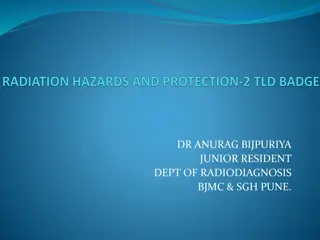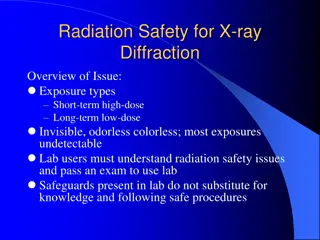Diagnostic Reference Levels in Medical Imaging and Radiation Protection
The concept of Diagnostic Reference Levels (DRLs) is crucial in evaluating the amount of ionizing radiation used in medical imaging procedures. DRLs help determine if radiation levels are appropriate and need optimization. Authorized bodies establish numerical DRL values as advisory guidelines. Local practices must be compared with DRL values for protection optimization. Proper education on DRLs is essential for healthcare professionals involved in medical imaging. DRL quantities assess radiation levels for specific imaging tasks and patient sizes, different from absorbed dose. Effective dose is not suitable as a DRL quantity.
Download Presentation

Please find below an Image/Link to download the presentation.
The content on the website is provided AS IS for your information and personal use only. It may not be sold, licensed, or shared on other websites without obtaining consent from the author. Download presentation by click this link. If you encounter any issues during the download, it is possible that the publisher has removed the file from their server.
E N D
Presentation Transcript
Diagnostic Reference Levels (DRLs) in Medical Imaging ICRP Publication 135 (2017) (Summary updated February 1, 2019) E. Vano , D.L. Miller, C.J. Martin, M.M. Rehani, K. Kang, M. Rosenstein, P. Ortiz-Lopez, S. Mattsson, R. Padovani, A. Rogers 1
Summary Summary (1) General (1) General The DRL process should be used to evaluate whether, in routine circumstances, the amount of ionising radiation applied for a medical imaging procedure at a local healthcare facility, when assessed for a representative sample of patients for a defined clinical task, is too high or too low. A DRL value is considered to be consistently exceeded when the local median value of the appropriate DRL quantity for a representative sample of patients within an agreed weight range is greater than the local, national, or regional DRL value. 3
Summary Summary (2) General (2) General DRLs may be established by authorised bodies. The numerical values of DRLs are advisory. However, an authorised body may require implementation of the DRL concept. Organisations responsible for different components of the tasks of collating data on DRL quantities and setting national DRLs should be identified in each country or region. DRL values shall not be used for individual patients or as trigger (alert or alarm) levels for individual patients or individual examinations. 4
Summary Summary (3) General (3) General Comparison of local practices with DRL values is not sufficient, by itself, for optimisation of protection. Action is required to identify and address any deficiencies. The highest priority for any diagnostic imaging examination is achieving image quality sufficient for the clinical purpose. Image quality must be evaluated as part of the DRL process, and methods to achieve optimisation should be implemented. All individuals who have a role in subjecting a patient to a medical imaging procedure should be familiar with the DRL process as a tool for optimisation of protection. The concept and proper use of DRLs should be included in the education and training programmes of the health professionals involved in medical imaging with ionising radiation. 5
Summary Summary (4) (4) DRLs DRLs quantities quantities Quantities used for DRLs should assess the amount of ionising radiation applied to perform a medical imaging task, and should be easily measured or determined. DRL quantities assess the amount of ionising radiation used for a medical imaging procedure, not absorbed dose to a patient or organ. The one exception is mammography, for which DG may be used. DRL quantities should be appropriate to the imaging modality being evaluated, to the specific study being performed, and to the specific size of the patient. The Commission stresses that the radiation protection quantity effective dose (used for other purposes in the ICRP radiological protection system) should not be used as a DRL quantity. It introduces extraneous factors that are neither necessary nor pertinent for the purpose of a DRL. 6
Summary Summary (5) DRLs (5) DRLs quantities quantities For projection radiography, two DRL quantities are recommended Ka,e (or Ka,i) and PKA in order to simplify assessment of proper use of collimation, especially in paediatrics. ICRU Symbol Meaning Other Common Symbols Ka,i Incident air kerma IAK Ka,e PKA Entrance-surface air kerma ESAK Air kerma-area product KAP DRL values developed for advanced digital radiographic techniques (e.g. tomosynthesis, dual-energy subtraction, contrast-enhanced subtraction, cone-beam CT) need to take the multiple image aspect of the technique into account, and should distinguish these procedures from more standard ones. 7
Summary Summary (6) DRLs (6) DRLs quantities quantities For mammography, the recommended DRL quantity is one or more of Ka,i, Ka,e, and DG, with the choice of quantity depending on local practices and regulatory requirements. For mammography, a simple approach could be setting DRL values for breasts of 5.0 0.5 cm thickness. Establishing DRL values for different breast thicknesses is a more complex but better approach to refine the DRL process for mammography. For interventional radiology, all of the following DRL quantities are recommended (if available): PKA, cumulative air kerma at Ka,r, fluoroscopy time, and the number of radiographic images (e.g. cine images in cardiology and digital subtraction angiography images in vascular procedures). 8
Summary Summary (7) DRLs (7) DRLs quantities quantities The recommended DRL quantities for CT are CTDIvol and DLP. The number of scan sequences in the examination may be helpful as well. SSDE provide more accurate estimates of paediatric patient doses than CTDIvol or DLP, which are both indices of the dose to standardised phantoms and may be used as an additional aid in optimisation. The recommended CTDIvol value to be used is the CTDIvol for each sequence. The recommended DLP value is the cumulative DLP for the entire examination. DLP values for individual scan sequences can also be useful, and may be used in addition to the cumulative DLP. 9
Summary Summary (8) DRLs (8) DRLs quantities quantities For nuclear medicine, the ideal DRL quantity would be the administered activity per body weight of a specific radionuclide for a specific clinical task and, if relevant, the radiopharmaceutical used. The Commission recommends that weight based administered activities should be used for children, adolescents, and low- weight patients, and considered for other groups. Setting a fixed maximum administered activity for very obese patients may also be considered. It is recognised that, in many countries, a standard activity is used in clinical practice for adult patients. Weight-based administered activities may not be appropriate for examinations where the radiopharmaceutical is concentrated predominantly in a single organ (e.g. thyroid scans, lung perfusion scans). 10
Summary Summary (9) DRLs (9) DRLs quantities quantities As DRL values for nuclear medicine procedures and CT procedures apply to radiation from very different modalities, and use different DRL quantities, for hybrid imaging procedures (SPECT- CT, PET-CT), it is appropriate to set and present DRL values for each modality independently. 11
Summary Summary (10) Median (10) Median values values Compliance with DRL values does not indicate that the procedure is performed at an optimised level with regard to the amount of radiation used. The Commission recognises that additional improvement can be obtained by using the median value (the 50th percentile) of the distribution used to set the national DRL value. This median value of the national distribution can serve as an additional tool to aid in optimisation, may be a desirable goal at which to aim using standard techniques and technologies, and represents a situation closer to the optimum use of the applied radiation. When the facility s median value of a DRL quantity is lower than the median value of the national distribution, image quality (or diagnostic information, when multiple images are used) might be affected adversely. Image quality should be considered as a greater priority in the review if additional optimisation efforts are undertaken. 12
Summary Summary (11) (11) Surveys Surveys and and registries registries The Commission recommends setting local and national DRL values based on DRL quantities for imaging examinations and procedures performed on patients. The use of phantoms is not sufficient in most cases. When phantoms are used, the effects of operator performance, the selected imaging protocol, and patient variability are not taken into account. The use of phantoms is important in the investigation of x-ray equipment performance, and is important in evaluating the performance of fluoroscopy and CT equipment with respect to the amount of radiation used during the optimisation of protection. Data on DRL quantities may be collected using surveys, registries, or other automated data collection methods. 13
Summary Summary (12) (12) Surveys Surveys and and registries registries Calibrations of all dosimeters, kerma-area product meters, etc., used for patient dosimetry should be performed regularly and should be traceable to a primary or secondary standard laboratory. The accuracy of DRL quantity data produced by and transferred from x-ray systems should be verified periodically by a medical physicist. The examinations/procedures included should, in general, represent the most frequent examinations performed in the region for which dose assessment is practicable, with priority given to those that result in the highest patient radiation dose. DRLs are not intended for use in radiation therapy, but they should be considered for imaging for treatment planning, treatment rehearsal, and patient set-up verification in radiotherapy. 14
Summary Summary (13) (13) Surveys Surveys and and registries registries National surveys and registries for setting DRL values should normally include medium- and large-sized healthcare facilities that have a sufficient workload to ensure that data for a representative selection of patients can be obtained. The sample should also cover the range of healthcare providers. For large countries, a survey of a random selection of a small proportion of all the healthcare facilities in the country can provide a good starting point for setting national DRL values, if no national registry or method for automated data collection exists. Results from 20 30 facilities are likely to be sufficient in the first instance. In a smaller country with fewer than 50 healthcare facilities, an initial survey of 30 50% of them may suffice. A survey for a particular examination in a facility should normally involve collection of data on DRL quantities for at least 20 patients, and preferably 30 patients for diagnostic fluoroscopy and CT examinations, and 50 patients for mammography. For paediatrics, these figures may need to be decreased for facilities where relatively few children are examined. For registries, all available and appropriate data should be used. 15
Summary Summary (14) (14) Surveys Surveys and and registries registries There should be some standardisation of weight for adult patients included in surveys of diagnostic procedures if data are collected from fewer than 50 patients (e.g. patients with weights between 60 and 80 kg for a mean weight of 70 5 kg). HIS and RIS can provide data for large numbers of patients, but may not include patient weight. As with all DRL surveys, the results rely on the accuracy of data entry. RIS and associated software may permit data on DRL quantities to be obtained in an automated fashion, either locally or through a national registry. When automated processes are used, the data for all cases of a specific procedure should be obtained and used for optimisation. 16
Summary Summary (15) (15) Setting Setting DRL DRL values values The DRL value should be tied to defined clinical and technical requirements for the selected medical imaging task. The appropriate image quality or diagnostic information needed for the clinical task should be a priority when setting DRL values. DRL values may differ for different clinical tasks, especially for CT where visualisation of differences in the internal structure of tissues or identification of nodules is often important. Different tasks may require use of different image filters with varying exposure levels. It is important when developing DRL values that all data collected come from similar procedures across all participating facilities. This ensures that comparisons among facilities remain valid and useful. It may be important to specify, in detail, the views normally included and the clinical task associated with the procedure. This may be required where differing exposure factors or different views (or numbers of views) are employed for different clinical indications. When two imaging modalities are used for the same procedure (e.g. PET-CT, SPECT-CT), it is appropriate to set and present DRL values for both modalities independently. 17
Summary Summary (16) (16) Setting Setting DRL DRL values values DRL values are dependent on the state of practice and the available technology (including post-processing software) at a particular point in time. Median values (not mean values) of the distributions of data collected from a representative sample of patients within an agreed weight range should be used for comparison with DRL values. The mean can be affected substantially by a few high or low values. National DRL values should be set as the 75th percentile of median values obtained in a sample of representative centres. If regional (multi-national) DRL values are created, they should be set as the median value of the national DRL values (each of which is set at the 75th percentile) for the countries in the region. If the sample of available data is small, other approaches may be used by agreement among the involved countries. The process to set and to update DRL values should be both flexible and dynamic. Flexibility is necessary for procedures where few data are available (e.g. interventional procedures in paediatric patients), or from only one or a few centres. A dynamic process is necessary to allow initial DRL values to be derived from these data while waiting for a wider survey to be conducted. 18
Summary Summary (17) (17) Setting Setting DRL DRL values values When a procedure is not performed on a regular basis in most hospitals, local DRL values may be determined using the data from a single large hospital with a relevant workload of procedures (e.g. a specialised paediatric hospital). Local DRL values set by a group of radiology departments can play a role, where effort has already been invested in optimisation. The group could set a local DRL value based on more regular surveys of local practice that will normally be lower than any national DRL value. Where the number of facilities or x- ray rooms is small, the median of the distribution of values of the DRL quantity is recommended as a typical value . Typical values can also be set for newer technologies that enable decreased amounts of radiation to be used in achieving a similar level of image quality. Published DRL values should be accompanied by a statement of the local group, nation, or region from which the patient data were collected, the size of the standard patient on whom the data are based, the details of the specific examination, as appropriate, and the date of the survey. 19
Summary Summary (18) (18) Interventional Interventional procedures procedures The Commission recommends retaining the term diagnostic reference level for the DRL process as applied to interventional procedures. For interventional procedures, complexity of the procedure may be considered in setting DRL values, and a multiplying factor for the DRL value may be appropriate for more complex cases of a procedure. If possible, the data from all interventional procedures performed (not just from a limited sample) should be collated to derive local and national DRL values 20
Summary Summary (19) (19) Paediatric Paediatric DRLs DRLs A single representative patient should not be used to define DRLs for paediatric imaging, as weight in children can vary by a factor of more than 100 from a premature infant to an obese adolescent. The amount of radiation used for examinations of children can vary tremendously due to the great variation in patient size and weight, from neonates to adult-sized adolescents. This variation in patient radiation dose is appropriate. Variation in patient radiation dose due to incorrect technique or failure to adapt the imaging protocol from adults to children to account for both paediatric diseases and paediatric patient size is not appropriate. Weight bands are recommended for establishing paediatric DRL values for examinations of the trunk and should be promoted for paediatrics. Age bands can be used if age is the only available measure. 21
Summary Summary (20) (20) Paediatric Paediatric DRLs DRLs Age groupings are recommended for establishing DRL values for examinations involving the head. For CT, the DRL quantities are CTDIvol and DLP, based preferably on calibration with a 32-cm-diameter phantom for body examinations and a 16-cm diameter phantom for head examinations. Values for these quantities should be obtained from patient examinations. SSDE may be used as an additional source of information for optimisation. Modern CT scanners permit determination of effective diameter or patient equivalent thickness. This should be considered as an additional refinement for setting paediatric DRLs. For nuclear medicine imaging, consideration should be given to adjusting administered activities based on agreed factors linked to weight. Adjustments should be made for paediatric examinations. 22
Summary Summary (21) DRLs in (21) DRLs in clinical clinical practice practice National and regional DRL values should be revised at regular intervals (3 5 years) or more frequently when substantial changes in technology, new imaging protocols, or post-processing of images become available. Median values of the DRL quantity for medical imaging procedures in a representative sample of patients within an agreed weight range for a specific x-ray room, radiology department, or other facility should be compared with local, national, or regional DRL values to identify whether the data for that location are substantially higher or lower than might be anticipated. If a local or national DRL value for any procedure is consistently exceeded, an investigation should be performed without undue delay, and, if appropriate, corrective action should be taken. When corrective action is required, it is necessary to keep in mind that DRL values are not dose limits. Corrective action (optimisation of protection) should include a review of equipment performance, the settings used, and the examination protocols. The factors most likely to be involved are survey methodology, equipment performance, procedure protocol, operator skill, and, for interventional techniques, procedure complexity. 23
Summary Summary (22) DRLs in (22) DRLs in clinical clinical practice practice In the optimisation process, account must always be taken of the level of image quality required for the medical imaging task. Image quality must always be adequate to provide the information required for the clinical purpose of the examination and the actual size of the exposed patient. When a facility s median value of a DRL quantity is substantially less than the DRL value, image quality (or diagnostic information, when multiple images are used) might be affected adversely. Image quality should be examined as a priority when the examination protocol is reviewed. The DRL audit process does not stop after a single assessment. Repeat evaluations are required following any optimisation, and the whole process should be repeated after an appropriate time interval. Local surveys of DRL quantities should normally be performed as part of the QA programme unless these data are continuously submitted to a registry, in which case, review of the registry data should be performed. A representative selection of examinations for each x-ray unit should be surveyed at intervals of about 3 years, and whenever substantial changes in technology or software have been introduced. 24
Example of audit cycle and optimisation flow chart (fig. from ICRP-135) 25
Summary Summary (23) DRLs in (23) DRLs in clinical clinical practice practice Local surveys of DRL quantities, as part of the QA programme, should be performed annually for CT and interventional procedures, unless these data are continuously submitted to a registry, in which case review of the registry data should be performed at least annually. Annual surveys or review of registry data are also appropriate as part of the QA programme for SPECT-CT and PET-CT. If continuous collection of data on DRL quantities is possible through registries or automated collation of data from electronic databases, the dose management process may take the form of a regular review of all the data to identify any adverse trends. The method for managing and achieving optimisation for dental radiography differs from the method for other x-ray applications. Dental DRL values are set in terms of incident air kerma measured during routine tests. Based on test results, recommendations can be made on changes to protocols (equipment settings) and adjustments. The investigator should work with the dentist to optimise protection. Improvement in protection linked to new technology can be realised which otherwise might not be achieved. 26























